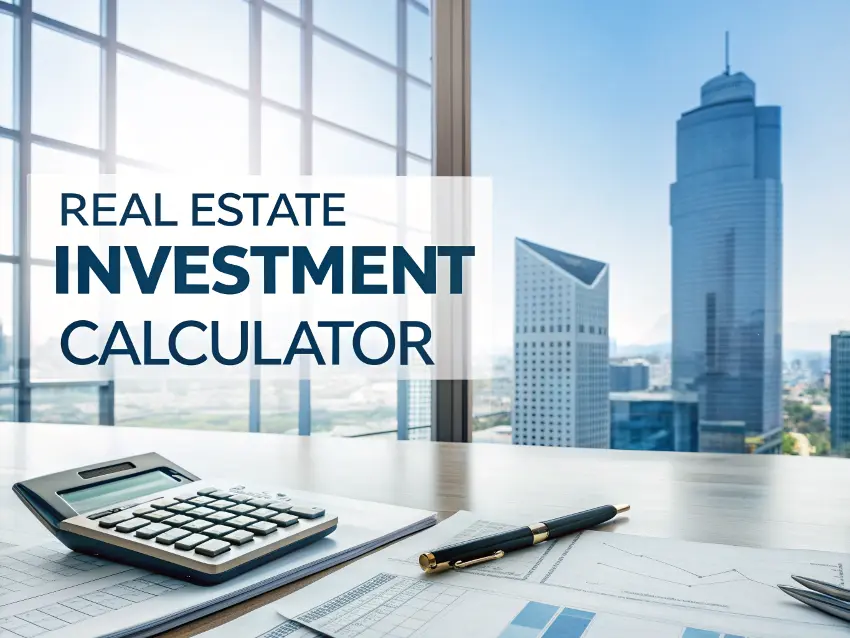Real Estate Investment Calculator
Analyze property investments and calculate potential returns

Real Estate Investment Analysis
Key Investment Metrics:
Cash Flow
The amount of money generated by a property after all expenses and mortgage payments are deducted from rental income.
Cash on Cash Return
The annual cash flow divided by the total cash invested, expressed as a percentage. Measures the cash income earned on the cash invested.
Cap Rate
The net operating income (NOI) divided by the property value, expressed as a percentage. Represents the property's rate of return regardless of financing.
Rent-to-Value Ratio (RV Ratio)
Annual rental income divided by property value, expressed as a percentage. A quick indicator of a property's potential profitability.
Break-Even Occupancy
The percentage of time a property needs to be occupied to cover all expenses. Lower percentages indicate less risk.
Investment Property Tips
- The 1% Rule: Monthly rent should ideally be at least 1% of the purchase price
- Cash Flow is King: Properties should generate positive cash flow after all expenses
- Factor in Vacancies: Always account for potential vacancies (typically 5-10%)
- Budget for Maintenance: Set aside 1-2% of property value annually for repairs
- Consider Property Management: Budget 8-10% of rent for professional management
Property Types:
Single Family Home
A standalone residential building designed for one family
Condo
An individually owned unit within a larger complex
Multi-Family (2-4 units)
A property with 2-4 separate dwelling units
Multi-Family (5+ units)
A larger apartment building with 5 or more units
Commercial
Property used for business purposes
Mixed-Use
Property combining residential and commercial spaces
Vacant Land
Undeveloped property without structures
Property Investment Analysis
Purchase Information
$
$
%
$
$
%
Rental Income
$
$
%
Operating Expenses
$
$
%
%
$
$
$
Long-Term Projections
%
%
Investment Analysis Results
Monthly Cash Flow:
$0.00
Cash on Cash Return:
0.00%
Cap Rate:
0.00%
Rent-to-Value Ratio:
0.00%(1% or higher is good)
Monthly Expenses:
$0.00
Break-Even Occupancy:
0.00%
Annual Expense Breakdown
Monthly Income (w/ Vacancy):
$0.00
Monthly Mortgage Payment:
$0.00
Expense Breakdown
Long-Term Projection (5 Years)
Future Property Value:
$0.00
Remaining Loan Balance:
$0.00
Estimated Equity at Sale:
$0.00
Total Return:
$0.00
Total Cash Flow:
$0.00
Annualized Return:
0.00%
Understanding Real Estate Investment Metrics
What Makes a Good Investment Property?
Cash Flow
Most experienced investors focus on positive cash flow rather than appreciation. A good investment property should generate at least $100-$200 per month in positive cash flow after all expenses (including vacancies and maintenance).
Cash on Cash Return
Aim for a minimum of 8-12% cash on cash return. Anything below 5% might not justify the risks and responsibilities of owning investment property compared to more passive investments.
Cap Rate
Generally, a cap rate of 4-5% might be acceptable in high-demand urban areas, while 7-10% would be expected in suburban or rural markets. However, higher cap rates often correlate with higher-risk areas.
The 1% Rule
A quick screening method: monthly rent should be at least 1% of the purchase price. While not a comprehensive analysis, properties meeting this criteria are more likely to generate positive cash flow.
Common Investor Mistakes
1
Underestimating Expenses
New investors often fail to account for all expenses, especially irregular ones like vacancy periods, major repairs, and capital expenditures (roof, HVAC, etc.).
2
Relying Too Much on Appreciation
Counting on property value increases rather than cash flow can be risky. Market fluctuations are unpredictable, and properties that don't cash flow can become financial burdens.
3
Ignoring Location Factors
Neighborhood quality, school districts, crime rates, and local employment opportunities significantly impact rental demand, tenant quality, and property appreciation.
4
Emotional Decision Making
Investment properties should be evaluated on numbers, not personal preferences. A property you wouldn't live in yourself might still be an excellent investment.
5
Inadequate Reserve Funds
Always maintain a cash reserve of at least 3-6 months' worth of expenses per property to cover unexpected repairs, vacancies, or market downturns.
Frequently Asked Questions
What's the difference between Cap Rate and Cash on Cash Return?
Cap Rate measures a property's performance regardless of financing, using the full purchase price in the calculation. Cash on Cash Return only considers the actual cash invested (down payment, closing costs), making it more relevant for leveraged investments.
How much should I budget for maintenance?
A common rule of thumb is the 1% rule for maintenance: budget about 1% of the property value annually. For older properties or those in harsh climates, consider budgeting 1.5-2%. Another approach is the 50% rule, which suggests that approximately 50% of your rental income will go to expenses (excluding mortgage payment).
Should I hire a property manager?
Property management typically costs 8-12% of monthly rent plus leasing fees. It's often worth considering if you: live far from your rental property, have multiple properties, have limited time, lack landlording experience, or dislike dealing with tenants. A good property manager can save time and reduce stress, but affects your cash flow.
What appreciation rate should I use for projections?
Historically, real estate appreciates at an average of 3-4% annually over the long term, roughly keeping pace with inflation. Using more conservative estimates (2-3%) for your projections is wise. Remember that appreciation varies significantly by location, and you should never count on appreciation as your primary return strategy.